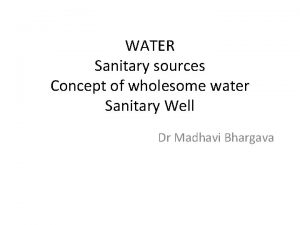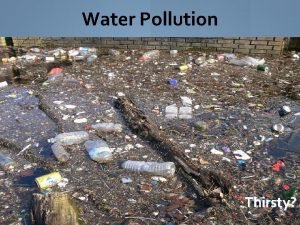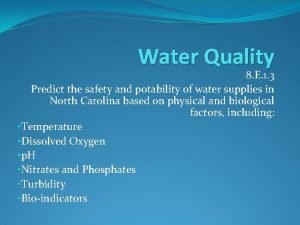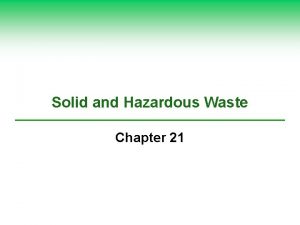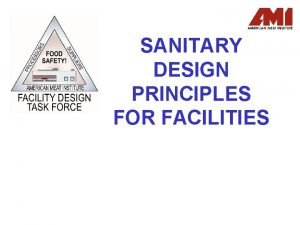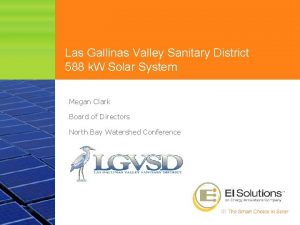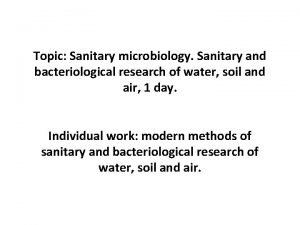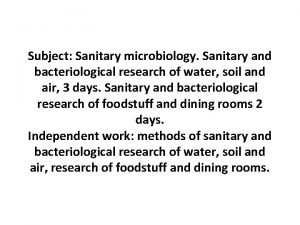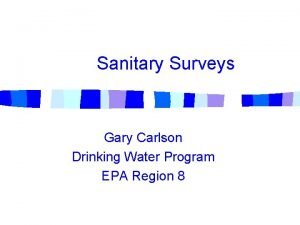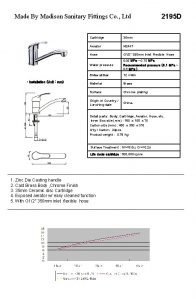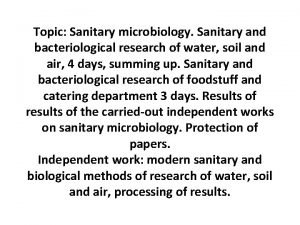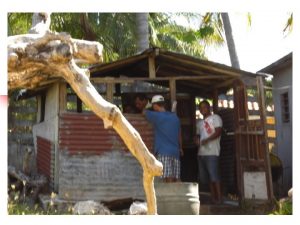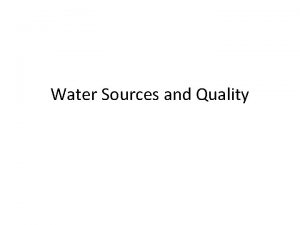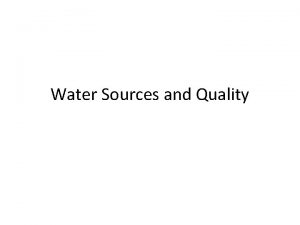WATER Sanitary sources Concept of wholesome water Sanitary





















- Slides: 21

WATER Sanitary sources Concept of wholesome water Sanitary Well Dr Madhavi Bhargava

Sanitation Science of safe-guarding health Deals with mostly physical and biological environment of man Physical: water, air, soil, housing, wastes, radiation etc Biological: plant and animal life, organisms, rodents, animals

Safe and Wholesome water • Free from pathogens • Free from harmful chemical substances • Pleasant to taste (free from color and odour) • Usable for domestic purpose

Water Requirement Survival 2 Litres per head Adequate supply Urban area 150 -200 Litres per head Adequate supply Rural area 40 Litres per head

Sources of Water Rain Purest form Soft water Picks up suspended impurities, micro -organisms and gases Soft water: corrosive to lead pipes Surface Water Ground Water Originates from rain water Eg: lakes, tanks, Impounding reservoirs, Rivers, streams Ponds and Lakes Shallow well Impurities from catchment areas SANITARY WELL Deep well Tube well Springs

Shallow and Deep wells Shallow well Deep Well Definition Taps water from above the first Taps water from below the impervious layer first impervious layer Chemical quality Moderately hard More hard as compared to shallow wells Bacteriologica Often grossly contaminated l quality Taps purer water Yield Provides a source of constant supply Usually goes dry in summer



Sanitary Water Sources: Ground water Wells and Spring GROUND WATER ADVANTAGES (superior to surface water): • Free from pathogens • Usually require little or no treatment • Supply is certain in all seasons • Less subject to contamination DISADVANTAGES: • Hard water • Requires some arrangement for pumping

Sanitary wells A sanitary well is one which is properly located, well-constructed and protected against contamination with a view to yield a supply of safe water


Features of sanitary well 1. LOCATION: a) Should be located at least 15 mts from source of contamination b) Should be at an elevation with respect to a possible source of contamination c) Within 100 mts or less from all users

2. Lining: bricks or stone up to a depth of 6 mts which is carried up to 2 -3 feet above the ground level. 3. Parapet wall: 70 -75 cm above the ground level 4. Platform: Cement/concrete platform of 1 mt in all directions 5. Drain: for the spilled water draining into public drain or beyond the cone of filtration

6. Covering: Cement/concrete slab 7. Hand-pump: Well maintained and robust hand-pump 8. Consumer responsibility: Strict cleanliness by consumers 9. Quality: Physical, chemical and bacteriological quality should be regularly monitored

Tube Well • Bacteriologically safe and cheap • Galvanized pipe sunk into water bearing stratum • Fitted with a strainer at the bottom • A Hand-pump on the top • Watertight platform with a drain all around • Average life: 5 -10 years or even up to 30 years • Deep tube-well: complicated drilling equipment and engineering methods • Ideal and do not depend on rain

Natural springs A spring is any natural situation where water flo ws from an aquifer to the Earth's surface. It is a component of the hydrosphere.

Springs • Ground water comes to surface and flows freely under pressure • Shallow type and deep type: • Former dry up during summer

• No pumping is required • Well-built protective structures for maintaining sanitation


Acknowledge the contrast

 Definition of sanitary well
Definition of sanitary well Water resources important
Water resources important Print and web sources
Print and web sources Water and water and water water
Water and water and water water Examples of point source pollution
Examples of point source pollution 10 sources of water
10 sources of water What is water
What is water Predict the sources of water
Predict the sources of water Define real self
Define real self Pengertian pemasaran
Pengertian pemasaran Trend sanitary
Trend sanitary Sanitary landfill
Sanitary landfill Sanitary facilities and equipment
Sanitary facilities and equipment Sanitary supplies wholesaler
Sanitary supplies wholesaler Sanitary equipment design principles
Sanitary equipment design principles Las gallinas valley sanitary district
Las gallinas valley sanitary district Hygienic pontic bridge
Hygienic pontic bridge Sanitary microbiology
Sanitary microbiology Sanitary microbiology
Sanitary microbiology Sanitary microbiology
Sanitary microbiology Epa sanitary survey
Epa sanitary survey Castelli sanitary
Castelli sanitary
